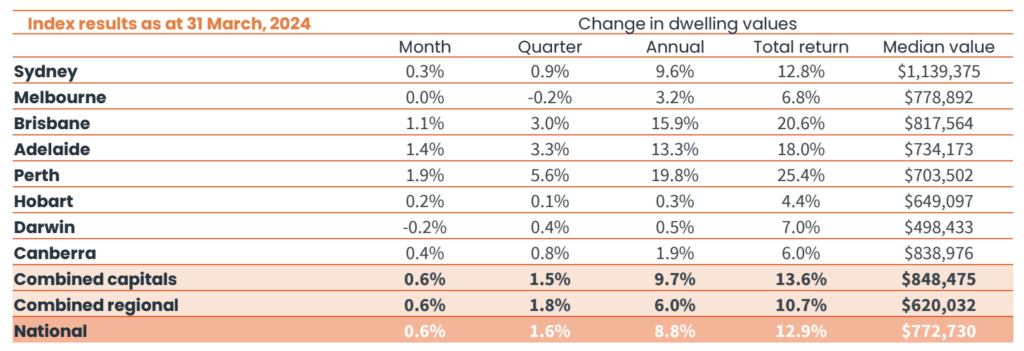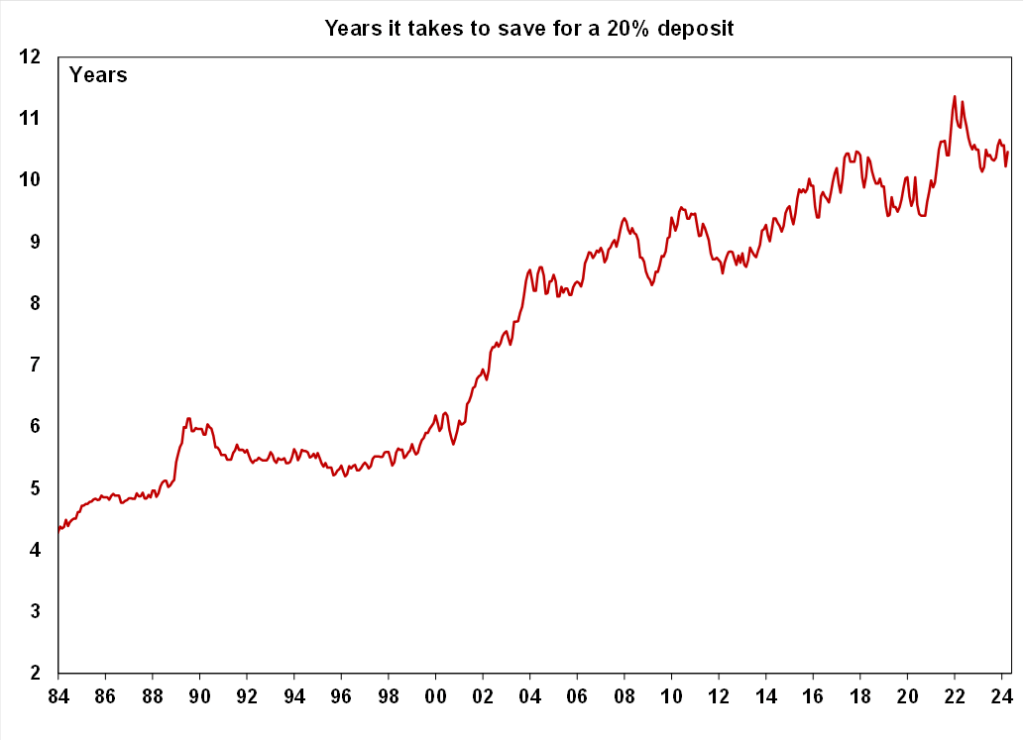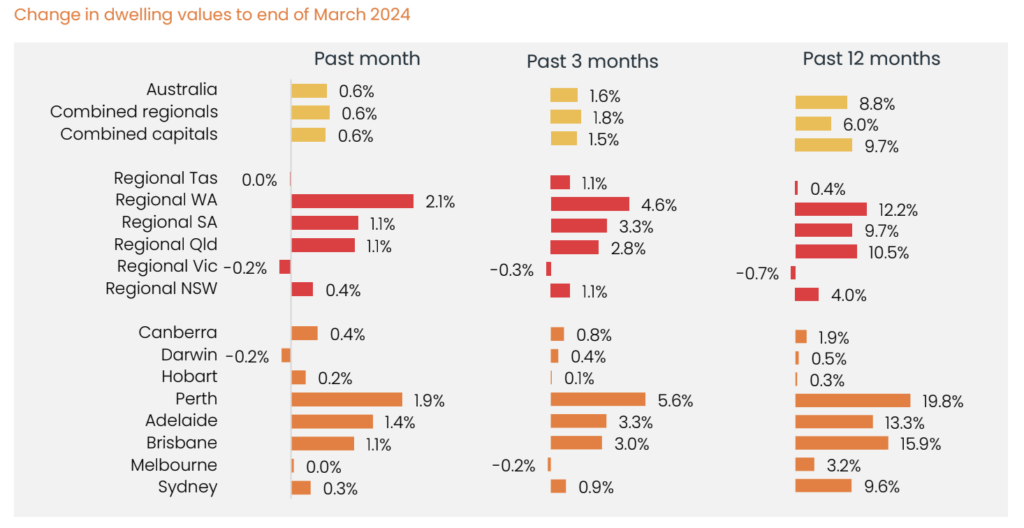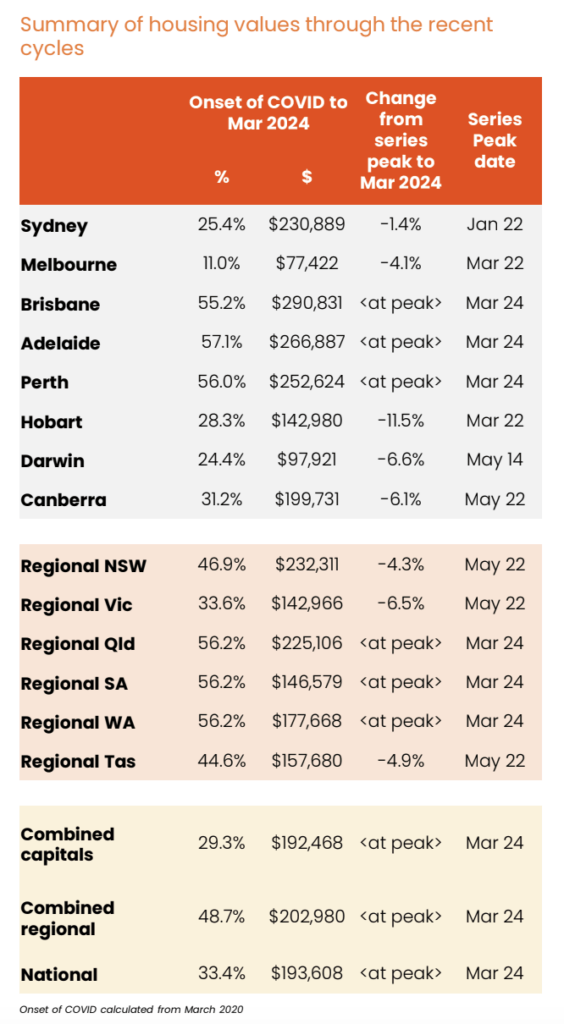It’s Australia’s 14th straight month of soaring home prices
News
Aussie home prices rose by 0.6% in March, according to new data from CoreLogic. That means national housing values have been rising steadily for 14 straight months.
Over the year, home prices are up by 8.8%. In Perth, last month alone prices grew by 1.9%.
The median value of a home in Australia is now worth $772,730.
Since prices stumbled and fell some 7.5% between April 2022 and January 2023, Aussie home values have dusted themselves off and leapt higher by 10.2%, which in dollar terms is circa $71,830.
We’ve hit new national record highs every month since November last year, while prices have been on an uptrend since February last year, says AMP’s senior economist Diana Mousina.
And that’s happened right under the nose of the Reserve Bank hoisting interest rates throughout 2023 and the subsequent hit that’s supposed to have had on our capacity to snag a mortgage and go borrow some money.
“However, the pace of growth in home prices has slowed from high levels in mid-2023 when gains in prices were around 1%/month.
“Nevertheless, the strength of the housing market in Australia has been surprising in the face of the largest interest rate tightening cycle in Australia since the late 1980s,” Diana says.
Perth, Adelaide and Brisbane had the highest pace of growth and have had strong returns over the past year and dwelling prices in these capital cities are at a record high while home price growth in Darwin, Hobart and Canberra was softer and home values are still some way away from their record levels.
Melbourne price growth has been low in the last quarter while Sydney has been stronger and dwelling values are close to record highs.
Out of interest, the median value of a home in Sydney is the highest at $1,139,75 and the lowest in Darwin at $498,433.

Diana says our home price affordability is still a massive problemm, and that there’s a fistful of capital city home prices at a record highs.
“The years taken to save for a 20% deposit is at over 10 years – which has consistently gone up through time and traditional measures like housing debt to income ratios are around a record high in Australia and above global peers.

“The persistent strength in home prices in this tightening cycle has been driven by very high population growth (which is adding around 220K/annum demand to housing) at a time of constrained housing supply. Despite the government’s ‘Housing Accord Policy’ which aims to build 1.2 million homes in 5 years, we are no where near that number with building approvals running at 162.7K over the past year,” Diana says.
Every capital city except Darwin (-0.2%) recorded a rise in dwelling values over the month, although CoreLogic’s research director, Tim Lawless, notes the monthly gains continue to be punctuated by diversity.
“At one end of the scale we have Perth’s housing market where values were up 1.9% over the month, followed by Adelaide and Brisbane with 1.4% and 1.1% growth. The remaining capitals are showing much lower rates of change, although Melbourne is the only capital city to record a negative quarterly movement, down -0.2% over the first three months of the year.”

The national quarterly pace of growth has accelerated from 1.4% in Q4 last year to 1.6% in Q1 2024.
Although housing values are rising faster than at the end of last year, the quarterly trend of growth has halved relative to the middle of last year when home values were rising 3.3% quarter-on-quarter.
“Rate hikes, cost of living pressures and worsening housing affordability are all factors that have contributed to softer housing conditions since mid-last year. However, an undersupply of housing relative to demand continues to keep upwards pressure on home values despite these headwinds,” Lawless says.
“The diversity in housing value outcomes can be explained by significant differences in factors like housing affordability, demand-side pressures from population growth and shortcomings in housing supply. Focusing on the extreme growth conditions in Perth, despite such a rapid pace of capital gains, housing values remain relatively affordable compared with the larger capital cities.”
“Housing remains in short supply and purchasing demand is still high due to interstate and overseas migration rates that are well above average.”
Tim says the population data out of the Bureau of Stats last month shows some of the extremes in both interstate and overseas migration trends for WA more broadly.
Net overseas migration to WA was running well above average at 18,122 in the September quarter of last year (up from a decade average of 4,639 per quarter), a trend seen in most states. Unlike some of the states, net interstate migration held well above the previous decade average of -96, reaching 2,237 in the quarter.
“The extreme flip in demographic trends has delivered a significant positive demand shock across WA housing,” Tim says.

After being led by the upper quartile most of last year, the strongest growth conditions have migrated to the lower quartile across most capital city markets.
Across the combined capital cities, lower quartile home values increased by 3.1% in the first quarter of the year compared with a 0.7% rise across the upper quartile of the market. This trend of stronger conditions across the lower value sector was evident in each of the major capitals.
“With housing affordability becoming more challenging and borrowing capacity lower than a year ago, it’s no surprise to see demand being skewed towards the middle-to-lower end of the value spectrum,” Lawless said.
Regional housing markets are also recording a rise in values, with similar levels of diversity as their capital city counterparts. Regional Victoria stands out with the softest growth conditions, with values down -0.3% in the first quarter of the year; the only broad ‘rest of state’ region to record a decline in values in the year-to-date.
The volume of home sales through the first quarter of the year was estimated to be 9.5% higher relative to Q1 last year, although comparison with a year ago is from a relatively low base, with the housing market bottoming out from the downturn at the beginning of last year.
Compared to the previous decade average for this time of the year, dwelling sales are estimated to be 3.7% higher.
